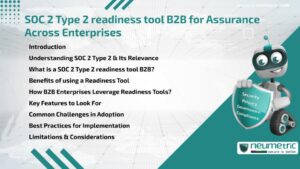Table of Contents
ToggleIntroduction
The Indian DPDPA Consent Withdrawal Process is a key mechanism in the Digital Personal Data Protection Act [DPDPA] that empowers Individuals to manage their Personal Data. Enterprises must provide users with simple, effective ways to withdraw Consent for Data Processing, ensuring Fairness, Transparency & Accountability. This process is not just a Regulatory requirement but also a way for Enterprises to build Trust & enhance Customer relationships.
Understanding Consent in the Context of DPDPA
Consent forms the foundation of lawful data processing under the DPDPA. Enterprises must seek clear & informed Consent before collecting or processing Personal Data. However, Consent is not permanent-it can be withdrawn at any time by the data principal. The Indian DPDPA Consent Withdrawal Process ensures that Enterprises respect this right & adjust their operations accordingly.
Why Consent Withdrawal is Crucial for Compliance?
Compliance with the DPDPA goes beyond collecting Consent; it extends to enabling its withdrawal. For Enterprises, this means:
- Upholding Individual rights to Privacy.
- Maintaining Business Objectives & Customer Expectations.
- Demonstrating Accountability in Data Handling.
- Avoiding Penalties for Non-Compliance.
Without proper Consent Withdrawal Mechanisms, Enterprises Risk Legal repercussions & a loss of Trust among Users.
Core Steps in the Indian DPDPA Consent Withdrawal Process
The process typically involves:
- User Request Submission: A User initiates withdrawal via Digital Portals, Apps or Written Communication.
- Verification: The Enterprise verifies the identity of the requester to prevent misuse.
- Action on Data: The Enterprise ceases data processing linked to the withdrawn Consent.
- Confirmation: A notification is sent to the User confirming withdrawal.
- Audit Trails: The process is documented to ensure Compliance.
These steps provide a structured approach that Enterprises can implement consistently.
Challenges Enterprises face in implementing Consent Withdrawal
While essential, the process poses challenges:
- Complex IT Systems: Legacy infrastructure may not support quick Consent revocation.
- Operational Disruptions: Stopping certain processes may affect Business Continuity.
- User Awareness: Many Users may not fully understand their withdrawal rights.
- Costs: Updating systems to support withdrawal can be resource-intensive.
These challenges highlight the need for strategic Planning & Investment.
Best Practices for Managing Consent Requests
Enterprises can improve the process by:
- Designing simple, user-friendly interfaces for Consent Withdrawal.
- Training Staff to handle Consent-related queries effectively.
- Automating withdrawal requests to ensure real-time response.
- Communicating clearly with Users about the impact of withdrawal.
- Conducting regular Compliance Audits.
Such practices streamline Operations & strengthen Compliance readiness.
Balancing User Rights with Enterprise Operations
A critical challenge is balancing User Rights with operational efficiency. While withdrawal must be respected, Enterprises may need to retain data for Legal or Contractual purposes. The Indian DPDPA Consent Withdrawal Process requires Enterprises to distinguish between Personal Data that can be deleted & data that must be retained for Compliance reasons. This balance ensures both Regulatory Compliance & Business Continuity.
Global Comparisons of Consent Withdrawal Mechanisms
Globally, Frameworks such as GDPR emphasise easy Consent Withdrawal Mechanisms. The Indian DPDPA Consent Withdrawal Process is aligned with these Standards but adapted for India’s diverse digital ecosystem, which includes Enterprises of varying sizes & digital maturity.
Limitations of Consent Withdrawal Processes
Even with robust systems, limitations remain:
- Not all data can be erased due to Legal obligations.
- Technical delays may slow withdrawal implementation.
- Smaller Enterprises may lack resources for advanced systems.
Recognising these limits allows Enterprises to manage User expectations realistically.
Takeaways
- Consent Withdrawal is central to DPDPA Compliance.
- The process ensures Fairness, Transparency & Accountability.
- Challenges include complex Systems, Costs & User Awareness Gaps.
- Best Practices include Automation, Training & User-friendly Portals.
- Enterprises must balance User rights with Legal & Operational needs.
FAQ
What is the Indian DPDPA Consent Withdrawal Process?
It is the process by which Individuals can revoke Consent for Personal Data processing under the Digital Personal Data Protection Act.
Why is Consent Withdrawal important under DPDPA?
It protects User rights, ensures Accountability & helps Enterprises avoid Penalties.
How do Users withdraw Consent under DPDPA?
Users can submit Withdrawal Requests through Enterprise Portals, Apps or Written Communication.
What challenges do Enterprises face in implementing Consent Withdrawal?
Challenges include Legacy IT Systems, Operational disruptions & high Costs of Compliance.
How can Enterprises streamline Consent Withdrawal?
By automating processes, simplifying User interfaces & providing clear communication.
Does withdrawal of Consent mean all data must be deleted?
Not always-some data may be retained for Legal or Contractual reasons.
Is the Consent Withdrawal Process the same across all Enterprises?
The Core Principles remain the same, but implementation may vary depending on Enterprise size & digital maturity.
Can Small Enterprises handle Consent Withdrawal effectively?
Yes, but they may require simplified Systems or Outsourced support.
Need help for Security, Privacy, Governance & VAPT?
Neumetric provides organisations the necessary help to achieve their Cybersecurity, Compliance, Governance, Privacy, Certifications & Pentesting needs.
Organisations & Businesses, specifically those which provide SaaS & AI Solutions in the Fintech, BFSI & other regulated sectors, usually need a Cybersecurity Partner for meeting & maintaining the ongoing Security & Privacy needs & requirements of their Enterprise Clients & Privacy conscious Customers.
SOC 2, ISO 27001, ISO 42001, NIST, HIPAA, HECVAT, EU GDPR are some of the Frameworks that are served by Fusion – a SaaS, multimodular, multitenant, centralised, automated, Cybersecurity & Compliance Management system.
Neumetric also provides Expert Services for technical security which covers VAPT for Web Applications, APIs, iOS & Android Mobile Apps, Security Testing for AWS & other Cloud Environments & Cloud Infrastructure & other similar scopes.
Reach out to us by Email or filling out the Contact Form…




